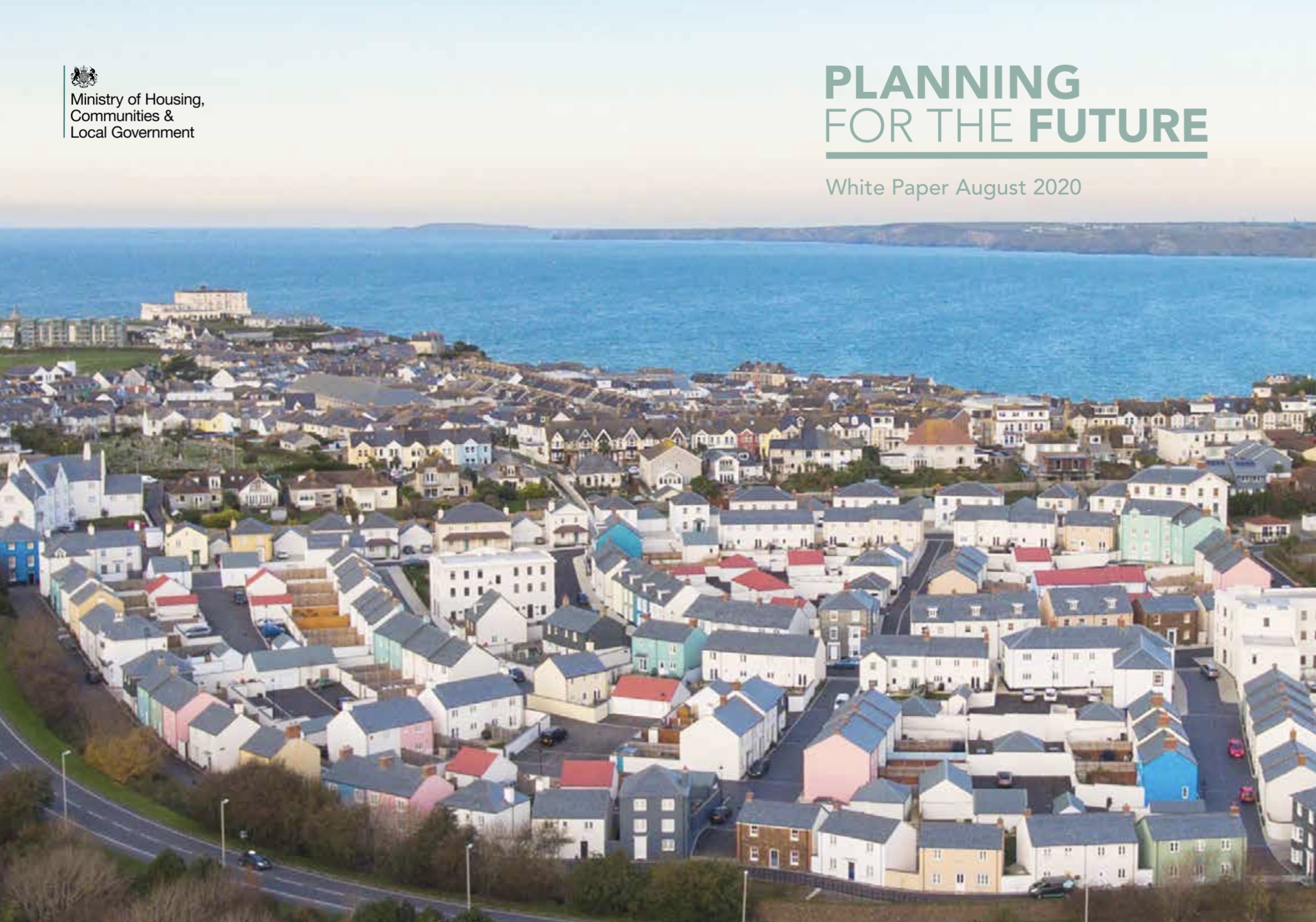
“Planning for the Future” White Paper: key takeaways for developers and land owners
Yesterday the Government published its long awaited White Paper on proposed reforms of the planning system in England: ‘Planning for the Future’ is the subject of a 12 week consultation running to 29 October. In so much as the Government’s promise for radical reform, it doesn’t disappoint. Running to 82 pages and 24 ‘Proposals’ in total, it sets out a root and branch review and change to the current system of plan making and development management. In the words of Boris Johnson in his foreword, the paper proposes ‘Radical reform unlike anything we have seen since the Second World War’ and in true Boris style, ‘No more fiddling around the edges, not simply painting over the damp patches, but levelling the foundations and building, from the ground up, a whole new planning system for England’.
So what’s proposed? Plenty and too much to cover in detail in an article such as this, however we have pulled out some key proposals and themes, which we think will be of interest to clients. We look forward to advising on the implications as the proposals make their way into a new system of plan making over the coming months.
The Paper describes three ‘Pillars’ of reform: Pillar One – Planning for Development; Pillar Two – Planning for beautiful and sustainable places; and Pillar 3 – Planning for infrastructure and connected places. In essence, the proposals seek to simplify the system of plan making and development management to bring certainty to the development process and quicken the delivery of much needed housing, while at the same time ensuring that the quality and sustainability of development is maintained and enhanced. Quite a task you may think and as always the devil is in the detail. We set out what we consider are three key themes of the proposals related to Plan Making, Development Management and Planning for Infrastructure:
Plan Making
The role of land use plans will be simplified with focus on three types of land:
- Growth areas – suitable for substantial development, with the terms ‘substantial development’ to be defined in policy to remove any debate – would include land suitable for comprehensive development, including new settlements and urban extensions, as well as areas for redevelopment such as former industrial sites and urban regeneration sites.
- Renewal areas – suitable for development – would cover existing built areas where smaller scale development is appropriate, including ‘gentle densification’ and infill of residential areas.
- Areas that are Protected – would include sites and areas which would justify more stringent development controls to ensure sustainability, including Green Belt, AONB, Conservations Areas, Wildlife Sites and areas of significant flood risk.
Development management policies will be established at national level, meaning that Local Plans will be restricted to ‘clear and necessary’ site or area-specific requirements, including broad height limits, scale and/or density limits for land in the Growth and Renewal Area. As a result, the Government expects Local Plans to be reduced in length by at least two thirds. Local authorities and neighbourhoods (through Neighbourhood Plans) will be expected to produce design codes and guidelines for new development with input from local communities to provide certainty and reflect local character. These could be produced for a whole Local Authority Area or for sub areas. With this focus on design at a local level, the Government is proposing that that each Local Planning Authority should appoint a Chief Officer for Design and Place Making, one of the recommendations of the Build Better, Building Beautiful Commission.
In the assessment of Local Plans, it is proposed to replace the existing test of soundness with a single statutory ‘sustainable development’ test in accordance with policy issued by the Secretary of State. It is proposed to abolish the Sustainability Appraisal system and develop a simplified process of assessing the environmental impacts of plans, as well as removing the Duty to Cooperate. A standard method for establishing housing requirement figures is also proposed to ensure enough land is released in areas where affordability is worst to stop land supply being a barrier to enough homes being built.
All this is expected to make for a more streamlined and in the words of the document, ‘engaging plan making process’. Under the proposals, the Local Plan process will be shorted to 30 months in total, covering five stages:
Stage 1 – ‘call for’ suggestions – 6 months
Stage 2 – plan preparation – 12 months
Stage 3 – parallel submission to Secretary of State and public consultation – 6 weeks
Stage 4 – examination and report by a Planning Inspector with the plan-making authority and those who submitted comments having a right to be ‘heard’
Stage 5 – finalise the plan and bring into force – 6 weeks
Local authorities will be expected to review their plans at least every five years. Failure to meet the timescales would put the Local Authority at risk of Government intervention, including the issuing of directions and preparation of the plan in consultation with local people.
Development Management
Areas identified in Growth areas will automatically be granted outline planning permission for the principle of development with planning decisions focused on resolving outstanding issues – either through a reformed reserved matters process or Local Development Order. In Renewal areas, there would be a presumption in favour of development established in legislation where consent would be granted in one of three ways – for pre-specified forms of development, through a new permission route giving automatic consent if a scheme meets design and other approval requirements; for other types of development, a faster planning application process; or through a Local or Neighbourhood Development Order. Meanwhile, in the Protected areas, proposals would come forward as they do now through planning applications made to the local planning authority.
The Government also proposes faster decision making and more certainty through firm deadlines and with greater use of digital technology. The established time limit of 8 weeks for minor and 13 weeks for major applications will be kept. However these will become firm deadlines, with the Government exploring the automatic refund of the planning application fee if local planning authorities fail to determine the application within the time limit (as well as deemed consent for some types of application if there has not been a timely determination). The Secretary of State will retain powers to call in an application and for applicants to appeal against decisions, although the Government expects to see fewer appeals due to the increased certainty in the application process. Interesting to note that in order to promote proper consideration of applications by planning committees, the Government is proposing that where applications are refused, applicants will be entitled to an automatic rebate of their planning application fee if they are successful at appeal.
Planning for Infrastructure
The Government is proposing that the Community Infrastructure Levy system is reformed to be charged as a fixed proportion of the development value above a threshold with a mandatory nationally-set rate or rates, and that the current system of planning obligations is abolished. The new ‘Infrastructure Levy’ would be charged on the final value of a development, based on the applicable rate at the point planning permission is granted and would be levied at the point of occupation rather than at commencement of development as it is currently. It will include a value based minimum threshold below which the levy would not be charged. This will help to prevent lower viability developments becoming unviable and where the value of development is above the threshold, the levy will only be charged on the proportion of the value that exceeded this. Local authorities will be allowed to borrow against Infrastructure Levy revenues so they can forward-fund infrastructure. In a further reform, it is proposed that the new Infrastructure Levy will also deliver affordable housing. In particular, local authorities will be able to use the funds raised through the levy to secure affordable housing. The reformed approach plans to continue to deliver on-site affordable housing at least at present levels.
Clearly, these major changes will not be without their challenges and the Government indicates that it will consider the arrangements for implementation to minimise disruption to existing plans and development proposals, and ensure a smooth transition. Nevertheless, the document indicates that that it intends to make rapid progress and in this regard have also today published a consultation on four short term measures to improve the current system with immediate effect:
- Changes to the standard method for assessing local housing need.
- Securing of First Homes, sold at a discount to market price for first time buyers, including key workers, through developer contributions in the short term until the transition to a new system.
- Temporarily lifting the small sites threshold, below which developers do not need to contribute to affordable housing, to up to 40 or 50 units.
- Extending the current Permission in Principle to major development so landowners and developers now have a fast route to secure the principle of development for housing on sites without having to work up detailed plans first.
The consultation also recognises that the reforms will have implications for the resources of planning departments and proposes to develop a comprehensive resources and skills strategy for the planning sector to support their implementation, including funding, planning application fees, and training.
Our Birmingham Planning Director, Paul Woods, commented:
“Change to the planning system has been overdue in the drive to increase the delivery of new housing, particularly in the current economic climate. The Government has recently introduced a raft of changes to increase the flexibility in the system including proposed changes to the use classes order and permitted development rights. Whether a complete overhaul of the system as now proposed is the right approach in these uncertain times remains to be seen. The new targets on local plan making and development management are demanding. One aspect that will require careful consideration is the resources available to our planning departments to re-skill and change focus in adapting to a new system. Whilst this is acknowledged by the Government, the proof will be in the pudding on delivery.”
If you would like to discuss a response to the consultation or talk about how this proposed reform might impact on your land interests, please get in touch with one of our Planning Directors:
Read the White Paper here.



